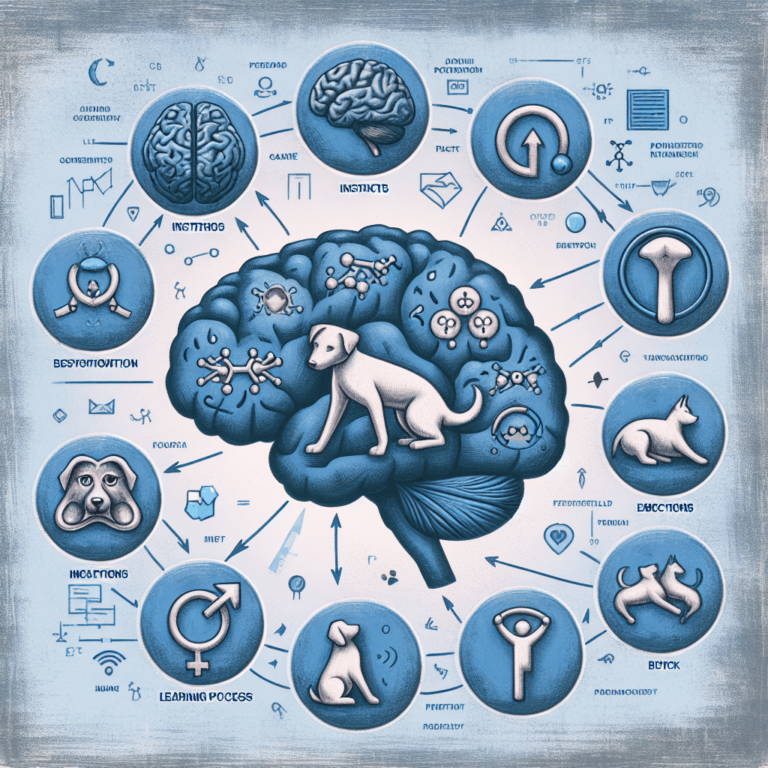In the fascinating world of dog training, understanding the underlying behavioral psychology is key to achieving successful results. By delving into the intricate workings of a dog’s mind, trainers can uncover the motivations and thought processes that drive their behaviors. From positive reinforcement techniques to establishing clear boundaries, exploring the fascinating subject of dog training behavioral psychology holds the key to unlocking the true potential of our furry companions.
Understanding the Basics of Dog Training
The Importance of Dog Training
Dog training is an essential aspect of responsible pet ownership. It not only helps to ensure your dog’s safety and well-being but also strengthens the bond between you and your furry friend. Training allows dogs to understand what behaviors are expected of them and teaches them how to navigate the world around them. Additionally, a well-trained dog is generally happier and more confident, which contributes to a harmonious household.
Ready for Cat Trivia?
Test your knowledge about cats!

Basic Techniques for Dog Training
Dog training techniques can vary, but there are a few fundamental methods that form the foundation of effective training. The two primary techniques used in dog training are classical conditioning and operant conditioning. Classical conditioning focuses on the association between environmental stimuli and behavioral responses, while operant conditioning involves shaping behavior through rewards and punishments.
The Role of Behavioral Psychology in Dog Training
Behavioral psychology plays a crucial role in dog training as it provides insights into how dogs learn and process information. By understanding the underlying principles of behavioral psychology, you can employ training techniques that are more effective and efficient. Key concepts such as classical conditioning, operant conditioning, positive reinforcement, negative reinforcement, and punishment all find their roots in behavioral psychology and can be applied to shape your dog’s behavior effectively.
Applying Behavioral Psychology in Dog Training
Classical Conditioning
Classical conditioning involves creating associations between a neutral stimulus and an unconditioned stimulus to elicit a desired response. For example, by associating the sound of a clicker with a tasty treat, you can condition your dog to associate the clicker sound with something positive, making it a useful tool in training. This technique can be used to teach basic commands or modify existing behaviors.
Operant Conditioning
Operant conditioning focuses on shaping behavior through rewards and punishments. It involves rewarding desirable behaviors to reinforce them and using punishments to discourage undesirable behaviors. Through the use of rewards, such as treats or praise, you can motivate your dog to repeat behaviors you want to encourage. Punishments, on the other hand, should be used cautiously and sparingly, as excessive or inappropriate punishment can have negative effects on your dog’s well-being and training progress.
Positive Reinforcement
Positive reinforcement is a central principle in dog training, relying on rewarding desired behaviors with something the dog finds enjoyable, such as treats, praise, or play. By rewarding your dog for performing the desired behavior, you reinforce that behavior and increase the likelihood of it being repeated. This positive approach to training fosters a healthy and trusting relationship between you and your dog.
Negative Reinforcement
Negative reinforcement involves removing or stopping an unpleasant stimulus to encourage desired behavior. This technique can be used effectively in training by removing an aversive stimulus, such as a tightening leash, when the dog performs the desired behavior, like walking calmly by your side. By reinforcing the absence of the aversive stimulus, you motivate your dog to continue exhibiting the desired behavior.
Punishment
Punishment should be approached with caution and used sparingly. It involves applying an unpleasant consequence to deter unwanted behaviors. It is important to note that punishment should never involve physical harm or abuse. Instead, it should be an immediate, proportionate response to the undesired behavior. When using punishment, it is essential to focus on redirecting your dog’s behavior towards more desirable actions rather than simply suppressing the unwanted behavior.

Using Rewards and Punishments Effectively
The Power of Rewards in Dog Training
Rewards are a powerful tool in dog training. They not only motivate your dog but also create a positive association with the desired behavior. By using rewards that are highly valued by your dog, such as their favorite treats or toys, you can make the training process enjoyable for both of you. Rewards should be delivered immediately after the desired behavior to reinforce the connection between the action and the reward.
Types of Rewards for Dogs
Dogs have individual preferences when it comes to rewards. Some dogs may be more food-motivated, while others may respond better to praise or play. It is important to understand what motivates your dog and tailor the rewards accordingly. Experiment with different types of rewards to find what works best for your furry companion.
Reward-Based Training Techniques
Reward-based training techniques involve using positive reinforcement to modify behavior. By consistently rewarding your dog for desirable actions, you can shape their behavior effectively. It is important to be clear and consistent in your commands, ensuring that your dog understands what behavior is being rewarded. Utilizing rewards to reinforce desired behaviors helps to establish good habits and encourages your dog to make positive choices.
Balancing Rewards and Punishments
Maintaining a balance between rewards and punishments is crucial in dog training. Over-reliance on either method can lead to ineffective training or even negative consequences. While rewards should be the primary focus, occasional and appropriate use of punishment may be necessary for certain behavioral issues. However, it is essential to seek professional guidance to ensure the proper and humane application of punishment.
Understanding the Limitations of Punishments
Punishments, when used improperly, can have unintended consequences. Harsh or inconsistent punishment can lead to fear or anxiety in your dog, potentially exacerbating the behavioral issue you are attempting to address. Additionally, punishment alone does not teach your dog what alternative behavior they should engage in. To effectively modify behaviors, it is crucial to focus on positive reinforcement and redirecting your dog towards more desirable actions.
Understanding Canine Behavior
Dog Communication and Body Language
Understanding dog communication and body language is fundamental to effectively train and interact with your canine companion. Dogs use a combination of vocalizations, body postures, and facial expressions to convey their emotions and intentions. Learning to interpret these signals can help you identify when your dog is feeling stressed, anxious, or comfortable, allowing you to tailor your training approach accordingly.
Common Behavioral Problems in Dogs
Dogs, like humans, can experience behavioral problems that can be addressed through training. Common behavioral problems include inappropriate elimination, excessive barking, aggression, separation anxiety, and leash pulling. Identifying these issues and seeking professional guidance can help you address them effectively, creating a more harmonious environment for both you and your dog.
Identifying the Triggers for Undesirable Behavior
To effectively address undesirable behavior, it is essential to identify the triggers that elicit these responses in your dog. Triggers can vary from environmental factors such as loud noises or unfamiliar people to internal factors like fear or anxiety. By identifying and addressing the underlying triggers, you can modify your dog’s behavior more effectively and focus on creating a positive and stress-free training environment.
The Role of Environment in Shaping Behavior
The environment plays a significant role in shaping a dog’s behavior. Providing a structured and enriched environment can help prevent boredom and undesirable behaviors. Training should not be limited to formal sessions but should be incorporated into the dog’s daily routine and environment. Creating a consistent and positive living space that promotes mental and physical stimulation can have a profound impact on your dog’s behavior and overall well-being.

Developing Effective Training Methods
Creating a Training Plan
A well-structured training plan is essential for effective and efficient dog training. It helps you stay organized and ensures that you are consistently working towards achieving your training goals. Your training plan should include specific commands or behaviors you want to teach, as well as a timeline for each step of the training process. Breaking down training into small, achievable steps makes it easier for your dog to learn and reinforces their confidence.
Setting Realistic Goals
When developing a training plan, it is important to set realistic goals that are attainable for both you and your dog. Expecting too much too soon can lead to frustration and may hinder progress. By setting achievable incremental goals, you can build on small successes, keeping your dog motivated and engaged in the training process.
Building Trust and Bond with Your Dog
Establishing trust and building a strong bond with your dog is crucial for successful training. Dogs are more likely to respond positively to training when they feel safe, loved, and understood. By using positive reinforcement and spending quality time engaging in activities your dog enjoys, you can foster a trusting relationship and create a solid foundation for training.
Consistency and Timing in Training
Consistency is key in dog training. Dogs thrive on routine and clear expectations. It is important to use consistent verbal cues, hand signals, and rewards to ensure that your dog understands what behavior is being rewarded. Additionally, timing is crucial in training. Rewards should be delivered immediately after the desired behavior to reinforce the connection between the action and the reward in your dog’s mind.
Using Positive Reinforcement to Modify Behavior
Positive reinforcement is a powerful tool for modifying behavior. By consistently rewarding your dog for the desired behavior and ignoring or redirecting unwanted behavior, you can shape their behavior effectively. Remember to focus on rewarding when your dog exhibits the desired behavior rather than punishing when they make a mistake. Positive reinforcement creates a positive learning environment and helps your dog associate training with enjoyment.
Addressing Specific Behavioral Issues
House Training and Crate Training
House training is one of the initial steps in dog training. It involves teaching your dog appropriate elimination habits and establishing a routine. Crate training can be a useful tool in house training as it creates a safe and comfortable space for your dog. Consistency, patience, and positive reinforcement are key when addressing house training and crate training.
Leash Walking and Heel Training
Leash walking and heel training help teach your dog proper leash manners and ensure their safety during walks. Consistency in training, positive reinforcement, and clear communication are essential for successful leash walking. Heel training involves teaching your dog to walk calmly by your side, following your lead. This advanced skill requires patience, practice, and the use of rewards to motivate your dog.
Barking and Howling
Excessive barking or howling can be a common behavioral issue in dogs. It is important to identify the underlying triggers that cause your dog to bark excessively and address them accordingly. Training techniques such as redirection, desensitization, and teaching a “quiet” command can help you manage and modify your dog’s barking behavior effectively.
Aggression and Reactivity
Aggression and reactivity can be complex behavioral issues that require professional guidance. It is crucial to address these issues with a qualified trainer or behaviorist who can assess the underlying causes and develop a behavior modification plan. Training techniques for aggression and reactivity focus on positive reinforcement and gradual desensitization to help your dog feel more comfortable and confident in potentially triggering situations.
Separation Anxiety
Separation anxiety is a challenging behavioral issue that occurs when dogs become distressed or anxious upon being separated from their owners. This can lead to destructive behaviors, excessive vocalization, and even self-harm. Addressing separation anxiety requires a comprehensive approach that includes behavior modification techniques, environmental management, and, in severe cases, consultation with a professional behaviorist.

Recognizing Limitations and Seeking Professional Help
When to Consult a Professional Trainer or Behaviorist
Recognizing when to seek professional help is important for addressing complex behavioral issues. If you are facing challenges that you are unable to manage on your own or if you are concerned about your dog’s well-being, it is recommended to consult a professional trainer or behaviorist. They have the experience and expertise to assess your dog’s behavior, identify underlying causes, and develop a tailored behavior modification plan.
Choosing the Right Trainer for Your Dog
When selecting a professional trainer or behaviorist, it is crucial to choose someone who uses positive reinforcement techniques and has a solid understanding of canine behavior. Look for trainers who have certifications or qualifications from reputable organizations and ask for recommendations from trusted sources. A good trainer will not only focus on training your dog but also empower you with the knowledge and skills to continue the training effectively.
Understanding the Difference Between Training and Behavior Modification
Training focuses on teaching your dog new skills and behaviors, while behavior modification addresses existing behavioral issues. It is important to understand the distinction between the two, as behavior modification requires a deeper understanding of your dog’s triggers and underlying causes. While training techniques may be helpful in behavior modification, seeking professional help is often necessary for addressing complex behavioral issues.
Considering the Individual Needs of Your Dog
Every dog is unique, with individual personality traits, strengths, and areas for improvement. It is important to consider your dog’s specific needs when developing a training plan. Take into account their breed, age, physical abilities, and temperament when choosing training techniques and setting goals. Adapting your approach to suit your dog’s individual characteristics ensures a more successful and tailored training experience.
Maintaining Training Results
Consistency in Reinforcement
Consistency is key in maintaining training results. Once your dog has learned a behavior or command, it is important to continue reinforcing it consistently. Regular practice sessions, repetition, and rewards help to reinforce and strengthen learned behaviors. Without ongoing reinforcement, your dog may start to forget or become inconsistent in their responses.
Continuing Education and Enrichment
Learning never stops, and dogs thrive on mental stimulation. Continuing to engage in training sessions and providing enrichment activities keeps your dog mentally engaged and sharp. Incorporate new tricks or behaviors into your training routine to challenge your dog and prevent boredom. This ongoing education and mental stimulation contribute to a happy and well-adjusted dog.
Reviewing and Refreshing Training Commands
Periodically reviewing and refreshing training commands is important to maintain your dog’s responsiveness. This serves as a reminder for your dog about what is expected of them and reinforces their training. By practicing commands regularly, you can ensure that your dog remains reliable and responsive even in distracting environments.
Ongoing Socialization and Exposure
Socialization and exposure to various environments, people, and animals play a crucial role in maintaining a well-rounded and well-behaved dog. Encourage positive interactions and continue to expose your dog to new experiences throughout their life. Regular socialization helps prevent behavioral issues, such as fear or aggression towards unfamiliar people or animals, and contributes to a more confident and adaptable dog.

Building a Strong Relationship with Your Dog
Understanding Your Dog’s Needs
To build a strong relationship with your dog, it is essential to understand their needs. Dogs require physical exercise, mental stimulation, social interaction, and a sense of security. By meeting these needs, you can create a deep connection and promote a healthy and balanced lifestyle for your dog.
Building Trust and Respect
Trust and respect are the foundation of any strong relationship, and the bond between you and your dog is no exception. Building trust involves providing consistent care, offering positive reinforcement, and meeting your dog’s emotional and physical needs. Respect is earned through clear communication, setting boundaries, and using training techniques that prioritize your dog’s well-being.
Promoting Positive Interaction and Play
Positive interaction and play are essential for a healthy and bonded relationship with your dog. Engage in activities that your dog enjoys, such as interactive games, training sessions, or interactive toys. Play helps release excess energy, strengthens the bond between you and your dog, and creates positive associations with training and interaction.
Enjoying the Benefits of a Well-Trained Dog
The benefits of a well-trained dog extend beyond their behavior. A well-trained dog is a pleasure to be around, as they are more likely to exhibit desirable manners and respond to commands. This enhances your daily interactions, making routines and outings more enjoyable and stress-free. A well-trained dog can participate in various activities and safely explore the world around them.
Conclusion
Effective Dog Training Through Behavioral Psychology
Dog training, when rooted in an understanding of behavioral psychology, can be both effective and rewarding. By applying techniques such as classical and operant conditioning, positive reinforcement, and understanding canine behavior, you can shape and modify your dog’s behavior in a humane and efficient manner. Setting realistic goals, addressing specific behavioral issues, and maintaining training results contribute to a well-trained and happy dog.
The Key Elements for Successful Dog Training
Successful dog training lies in a personalized approach that considers your dog’s individual needs, preferences, and limitations. Building trust, maintaining consistency, and using positive reinforcement are key elements in shaping desired behaviors. Seeking professional guidance when needed and continuously enriching the training experience ensures ongoing growth and development in training techniques.
Continued Growth and Development in Training Techniques
Dog training techniques continue to evolve as our understanding of canine behavior deepens. Staying informed and open to new developments in training can contribute to a more effective and enjoyable training experience for both you and your beloved canine companion. By embracing continued growth and development, you can keep your training techniques current and provide your dog with the best possible training experience.



